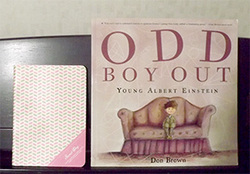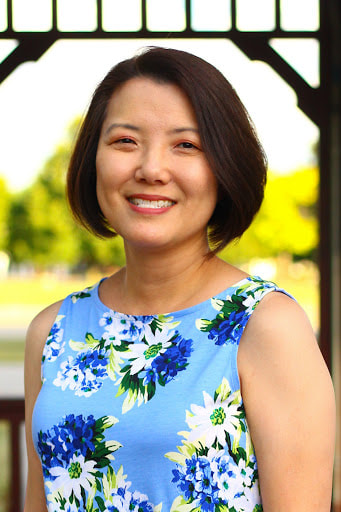 Happy 2014! Since it's the beginning of a new year, I thought I'd talk about the beginnings of picture book biographies because that's what I've been studying lately. But first I want to share 2 little gifts from my 2 kids. They saw my Amazon Wish List where I've been adding books I wanted to read, especially biographies. They wrote down the titles, but I thought, there's no way they can get these here in Korea. But I was wrong. At the English bookstore they had Odd Boy Out. My son gave me the small notebook because I'm always buying notebooks for my writing. Now onto picture book biography beginnings. As with all picture books, the story's first line must hook you in. And with a historical book, I feel it's even more crucial. Kids usually gravitate toward fiction books, but nonfiction has become more interesting in this generation. I analyzed 15 recent picture book biographies and noticed picture book biography first lines could be categorized as follows: Think about which kinds of beginnings draw you in more. Bio + Quirk- This beginning tells you a little about the person and what makes them different or lists the quirk that makes them special. Diego Rivera was born in Mexico in a city called Guanajuato, which means land of frogs. As a boy Diego enjoyed playing with his trains, but more than anything he liked to draw. ~ Diego Rivera: His World and Ours by Tonatiuh Duncan, Abrams 2013 Setting + Quirk- This lists the setting plus the person's quirk that makes them special. In Venice of long ago, there lived a man who daydreamed in music. ~ Vivaldi and the Invisible Orchestra by Stephen Costanza, Henry Holt 2012 President Abraham Lincoln had just declared war on the Southern states seceding from the Union, and the new army needed men. When Frank Thompson saw a poster requesting recruits, he decided he would be one of them. Except Frank wasn’t his real name. In fact, Frank wasn’t a man. He was really Sarah Emma Edmonds. ~ Nurse, Soldier, Spy: The Story of Sarah Edmonds, Civil War Hero by Marissa Moss, Abrams 2011 Setting only A steamship pulls into the harbor, carrying hundreds of immigrants—and a surprise for New York City. ~ Brave Girl: Clara and the Shirtwaist Makers' Strike of 1909 by Michelle Markel, Balzer & Bray 2013 It was a cold and gray winter day when our ship docked in NYC. ~ Papa Is a Poet: A Story about Robert Frost by Natalie S. Bober, Henry Holt 2013 On a fine spring day in the Imperial Austrian City of Vienna, Wolfgang Amadeus Mozart glanced at the clock against the wall and sighed a great, long SIGH. ~ Mozart Finds a Melody by Stephen Costanza, Henry Holt 2004 It was the winter of 1775. The American Revolution had begun, and things weren’t going well for the Patriots of Boston, Massachusetts. ~ Henry and the Cannons: An Extraordinary True Story of the American Revolution by Don Brown, Roaring Book Press 2013 Quirk only There once was a boy who loved math. ~ The Boy Who Loved Math: The Improbable Life of Paul Erdos, by Deborah Heiligman, Roaring Book Press 2013 Noah Webster always knew he was right, and he never got tired of saying so (even if, sometimes, he wasn’t). He was, he said, “full of CON-FI_DENCE” [noun: belief that one is right] from the very beginning. ~ Noah Webster and His Words by Jeri Chase Ferris, Houghton Mifflin 2012 Bio only Over 100 years ago, as the stars swirled in the sky, as the Earth circled the sun, as the March winds blew through a little town by a river, a baby was born. His parents named him Albert. ~ On a Beam of Light: The Story of Albert Einstein, by Jennifer Berne, Chronicle 2013 On a sunny, cold Friday in the old city of Ulm, Germany, a baby named Albert Einstein is born. It is March 14, 1879. ~ Odd Boy Out: Young Albert Einstein, by Don Brown, Houghton Mifflin 2004 Quote + What the Person Wants “I long to be a man,” Louisa May Alcott scribbled one day, “but as I can’t fight, I will content myself with working for those who can.” Coming from a family who was part of the Underground RR, to shelter runaway slaves, she burned to help the war effort. ~ Louisa May's Battle: How the Civil War Led to Little Women by Kathleen Krull, Walker 2013 Prior Knowledge or Text to Self - This begins with children thinking about what they already know. I’ll bet you’ve met plenty of doctors in your life. And I’ll bet lots of them were women. Well, you might find this hard to believe, but there once was a time when girls weren’t allowed to become doctors. ~ Who Says Women Can't Be Doctors? The Story of Elizabeth Blackwell by Tanya Lee Stone, Christy Ottaviano (Henry Holt) 2013 What would you do if someone told you can’t be what you want to be because you are a girl? ~ Elizabeth Leads the Way: Elizabeth Cady Stanton and the Right to Vote by Tanya Lee Stone, Christy Ottaviano (Henry Holt) 2010 Problem Eleanor’s father adored his “Little golden hair.” They talked. She danced for him. He hugged her and threw her into the air. He made her feel important and loved. But he drank a lot and wasn’t home much. Eleanor’s mother thought Eleanor was ugly and too serious. She called her “Granny” in front of people. Eleanor tried to please her mother by being good. It didn’t work so she just kept quiet. “I wanted to sink through the floor in shame.” ~ Eleanor, Quiet No More by Doreen Rappaport, Disney Hyperion 2009 *** Thanks to Amazon's "Look" feature, I can study some first lines. And maybe some titles could be in more than one category, but you can see a pattern of popular categories. And if you have other first lines of picture book biographies that you'd like to add, let me know! I did all this, just so I could write MY first line on my first draft. And who knows, it could still change. I hope this might be helpful sometime in your writing future. And I was just thinking--sometimes fiction picture books' first lines also fit these categories. Happy Writing!
44 Comments
1/7/2014 02:10:55 am
Just dropping by to say hello! I found you on 12x12-- I homeschool as well! Here's to a great year of writing!
Reply
1/7/2014 05:41:33 am
Well you've found my weakness, picture book biographies! I love what you have done in this post Tina. I think I will buy myself a small notebook to write down some opening lines as well and - more importantly - categorize them as to their type. Awesome!
Reply
1/7/2014 08:17:44 am
Hi Cathy,
Reply
1/7/2014 08:13:07 am
Tina, I had made a note to do this last year, but then forgot about doing so. Thank you for putting this together, you've inspired me again.
Reply
1/7/2014 09:15:32 am
Tina...thank you so very much. You just gave us all a mini-workshop class in writing first lines for biographies! You are amazing!
Reply
1/7/2014 09:20:17 am
Fantastic post, Tina! I love how you broke the openings down into types. That really helps other writers think about how to tackle an opening. I have to say, though, that opening about Eleanor (I'm assuming it's Roosevelt) makes my blood boil. What a horrible mother!
Reply
1/7/2014 09:30:19 am
There are definitely openings here that I think are more successful, more grabby than some of the others. Yet all were published! In reading to kids for years as a school librarian, I found they are less attracted beginnings that are settings or with a typical biographical sentence.
Reply
Kathleen C. Berman
1/7/2014 10:20:18 am
I love this post Tina. I have been doing something similar. I have been writing the opening and closing lines of all the picture book bios I have read. I like the way you categorized your study. I think picture book bios are fascinating. Maybe sometime we can swap our PB bios.
Reply
Patricia Toht
1/7/2014 11:20:23 am
Nice post, Tina! Thanks for the insights!
Reply
Todd
1/7/2014 11:43:23 am
Thank you for this study. I had never thought to use amazon in this way. While I love my trips to the library, this is more convenient. It also allows us to study what is 'hot.' Thanks!
Reply
Kristen
1/7/2014 09:34:02 pm
Fabulous!
Reply
1/7/2014 10:41:56 pm
What a brilliant post, Tina. I'm bookmarking it. I've been studying many of these same books, but didn't classify the openings. This is so helpful.
Reply
1/8/2014 01:45:36 am
These are excellent beginning ideas for nonfiction and fiction. With so much emphasis on "character driven stories," this really shows how to establish "character" from line #1. Thanks for compiling this list!
Reply
1/8/2014 01:42:05 pm
Tina, what a brilliant way to analyze these picture book biographies. Thanks for sharing your expertise!
Reply
Wendy Greenley
1/9/2014 01:40:40 am
Tina, I love the way you made these categories! Thanks for sharing this.
Reply
1/9/2014 11:13:18 pm
Tina, How did I miss this post? Very informative and I really appreciate your using the books as examples to show the different kinds of openings. I'm going to pick up Odd Boy Out. My 7 year-old will love it. The Boy Who Loved Math is one of my son's favorite books. Great post!
Reply
7/13/2014 10:45:02 am
This is a terrific and fabulously informative and helpful post, Tina! Thanks so much! :)
Reply
Shelly (Michelle) Pollock
4/24/2018 06:09:30 am
Tina
Reply
Shelly (Michelle) Pollock
4/24/2018 06:10:50 am
Tina -
Reply
Leave a Reply. |
Tina M. Cho, children's authorI'm a children's author and freelance writer for the educational market. Welcome! Archives
March 2024
Categories
All
|




 RSS Feed
RSS Feed
